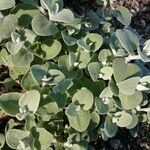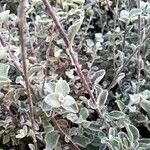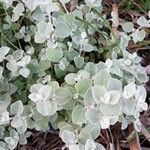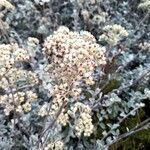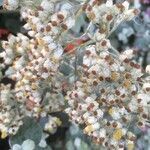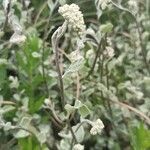Straggling, loosely branched, soft-wooded shrub, forming tangled masses. Stems thinly grey-woolly, leafy becoming distantly bracteate below inflorescences. Leaves 10-35 x 10-30 mm, both surfaces grey-woolly felted, upper surface sometimes only cobwebby; petioles up to 10 mm long, base auriculate. Capitula many, subglobose to broadly campanulate, 5 x 5 mm; involucral bracts in 5 series, opaque milk-white. Flowers 18-30, yellow, sweetly scented. Flowering time Dec., Jan. Pappus of bristles, with bases cohering strongly by patent cilia, also lightly fused. Cypselae 1 mm long, barrel-shaped, 5-ribbed.
Shrubs or subshrubs, aromatic, to 60 cm. Stems loosely branched, straggling. Leaves petiolate; blades ovate, 1–2 cm, apices obtuse to subacute, faces concolor, silvery green, woolly-tomentose. Phyllaries creamy white.
Like H. pandurifolium but leaves abruptly and conspicuously petiolate and not crisped, and involucral bracts obtuse.
